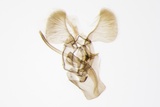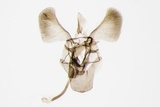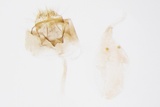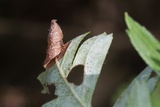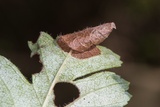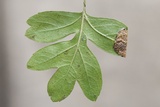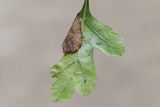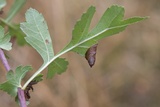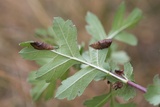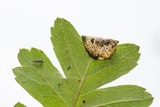Parornix anglicella (Stainton, 1850) Species
Last modified: Dec. 10, 2025, 2:05 p.m.
A common species in Belgium.
Details
- Classification
- Family: Gracillariidae > Subfamily: Gracillariinae > Tribus: Parornichini > Genus: Parornix > Species: Parornix anglicella
- Vernacular names
- Meidoornzebramot (NL), Hawthorn slender (EN), Weißdorn-Randfaltenmotte (DE)
- First mention in Belgium
- Fologne E. 1863. Addenda au catalogue des Lépidoptères de Belgique. — Annales de la Société entomologique belge 7: 87–93. On page 92. view page
- Status
-
Native
Distribution
Imago
Forewing ground colour is greyish with up to ten, sometimes rather inconspicuous, whitish striae at the costa; some dark brown dots in the center of the wing and near the inner margin. A certain identification of adults, without knowledge of the larval hostplant, is often impossible without reference to the genitalia.
Museum specimens
No pictures yet!Specimens in nature
No pictures yet!Mine
The first instar starts its mine on the underside of the leaf as a small, narrow gallery. This gallery is often covered by the next instar which forms a blotch mine, mostly at the tip of one of the leaf segments. Wherever the caterpillars consume the plant tissue, the mine turns brown, at first just some small brown spots, but later on the entire mine.
See also gracillariidae.net and bladmineerders.be.
Bionomics
Later instars deposit their frass as small blackish grains inside the mine. Free-living stages spin a downwards-turned leaf segment into a fold or cone under which they live and of which they also consume the entire palisade parenchyma, causing the fold to turn brown. Two successive cones are constructed.
Pupation in that folded leaf edge or on leaf litter.
Adults hide during the day but become active at dusk and at night. They come to light.
Flight periods
The adults fly in two generations a year during April and May and again during August.
Observed on
- Host plant (species):
- Crataegus monogyna and Crataegus laevigata
- Host plant (genera):
- Crataegus
The larvae feed usually on Crataegus but occasionally also on other Rosaceae, like Mespilus, Sorbus aucuparia, Fragaria and Cotoneaster.
Habitat
Garden or road borders with Crataegus, forests with individual Crataegus bushes.
